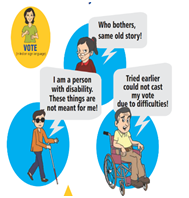

Context
Recently, a petition admitted by the Supreme Court that called for the introduction of ITTS technology to allow blind voters to verify their votes has set off a debate, with some disability rights activists raising concerns over the practical issues that may crop up.
About
The present method
- At present, a blind voter could vote with the help of a companion who would be able to read the VVPAT slip or vote on their own using the Braille signs on the EVM, but not be able to verify the vote.
- This method raised issues of autonomy and secrecy.
|
Voters with disabilities
|
Barriers to electoral participation for PwD category
- inadequate or inaccessible voter education
- difficulties in voter registration and physical access to polling stations
- inability to vote independently and privately
- absence of or inappropriate assistance from poll personnel
How ITTS software can help?
- It is a stand-alone, real-time system to capture the image of the paper slip generated by the printer in VVPAT, extract text from it and convert the text into speech that can be listened to through the headphones.
- The ITTS device consists of four main components:
- Camera
- programmable system (optical character recognition software and text-to-speech engine)
- headphones
- battery

Constitutional Rights:
- Article 41 of the Directive Principles of State Policy (DPSP) states that State shall make effective provision for securing right to work, to education and to public assistance in cases of unemployment, old age, sickness and disablement, within the limits of its economic capacity and development.
- The subject of ‘relief of the disabled and unemployable’ is specified in state list of the Seventh Schedule of the constitution.
Possible Impacts:
|
Positive |
Negative |
|
|
Suggestive measures
- Provisions for community training and people participation must be included.
- Inclusion of alternate equipment in case of technological failures.
- Educate the stakeholders regarding their rights and duties.



